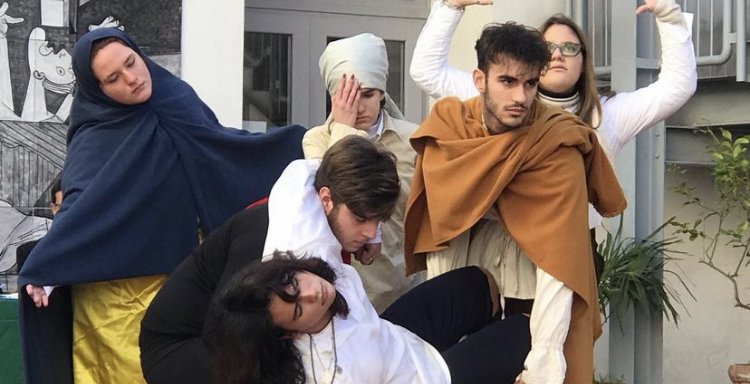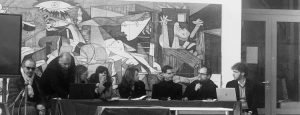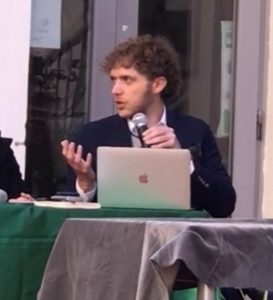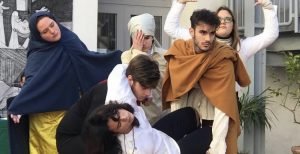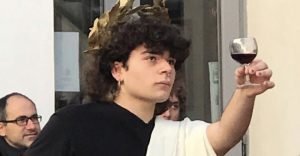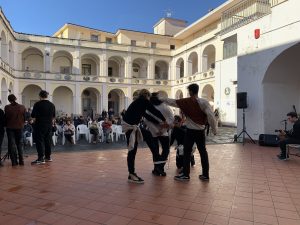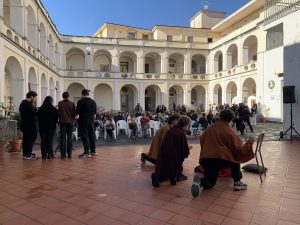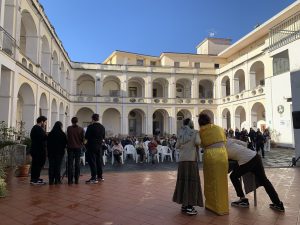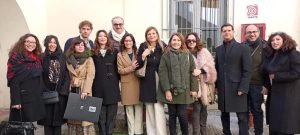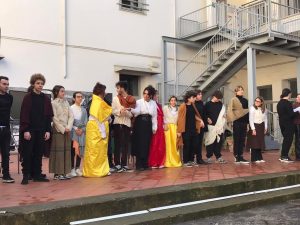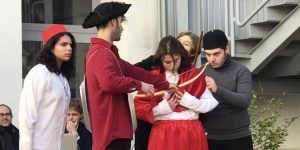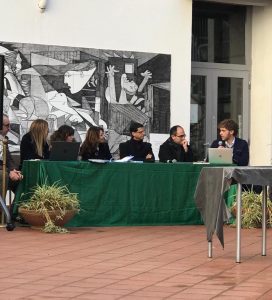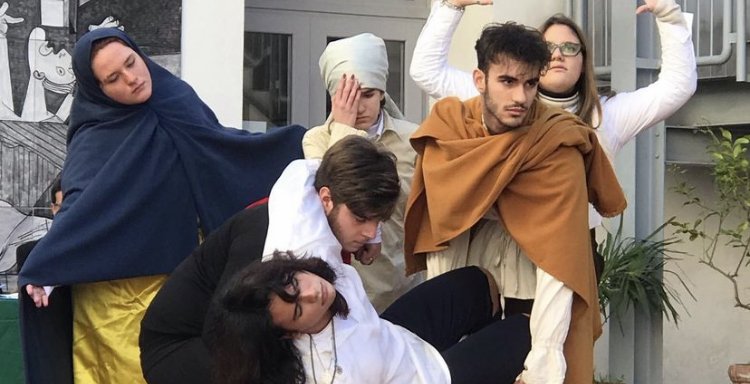
It was a morning full of insights and comparisons in the name of culture and art that of January 14 at the Liceo Artistico “Leonardo Da Vinci” in Aversa. The “Literary Café. Caravaggio & Pasolini” began with greetings from the director of instinct Margaret Montalbanoafter which there was the intervention of the professor Rosalba Corvino. They both talked about how the idea of the literary café was born and in particular Professor Corvino said:
“I was with the principal when she expressed the desire to organize a literary café at our school, which would anticipate the open day, also to be able to strengthen relations with the local cultural associations with which we have already been working for some time. At that moment, I remembered that the night before I had a little peek on fb and read a nice post from my dear friend Pasquale Vitale just got back from watching the film on Caravaggio, this passage struck me “In this slightly noir film, the persecuted Caravaggio is somewhat reminiscent of Pasolini who sought the sacred in the suffering and lacerations of the least. The first put on canvas the many Christs on the cross of his time, the second will immortalize them on paper and film”
So I didn’t hesitate to suggest a literary café on Caravaggio & Pasolini, what I later discovered to be a classic by Vittorio Sgarbi, and from there the idea started, the comparison with my colleagues and the machine of collaboration between us started professors of the art & culture commission. We immediately took steps to involve external experts and relevant departments.
The painter Caravaggio and the writer Pasolini share existential events with strong convergences. The strong affinity between the end of Pasolini and the end of Caravaggio has also been underlined by Federico Zeri. The similarity of the existential story and the tragic end of the two is so seductive, that many have gone in search of analogies, evidence and common features between the Lombard painter and the Friulian intellectual, poet, novelist and director. In any case, Caravaggio is one of my favorite artists, the only one able to arouse emotional emotion in me, I don’t deny that I cried in front of Caravaggio’s Flagellation of Christ in Capodimonte, when I saw it for the first time. And I think I’m not the only one to feel that sense of involvement, that thrill of emotion, that strong curiosity, I explain it with pleasure and I also find great interest from the students. And so, in order not to make it purely aesthetic with our colleagues, we decided to write a dialogue on Caravaggio that collected his main curiosities, lightly and essentially capturing the poetics of the artist who revolutionized 17th century painting. The fact remains of him that he was too often labeled as a cursed, murderous and bloodthirsty painter, but it should also be remembered that he was an attentive reader of the Gospels, in fact the artist was one of the greatest interpreters of the true evangelical message of poverty and spirituality ”. The teacher Rosalba Corvino and the teachers Daniela Damiano and Maria Zaccariello they had the idea of writing a nice “Dialogue on Caravaggio”, which was interpreted by the students Roberta Masullo 5D, Mara Paolella 4C, Martina D’Ausilio, Filomena Palma 4C, Martina Sofa 4C, Fabozzo Giovanna 4B. Subsequently, very interesting interventions followed that captured the attention of those present, the first was the intervention of the art historian Ivano Iannielli, who spoke of Caravaggio’s youthful training and focused attention on Caravaggio’s realism of which we don’t talk much, as we prefer to focus on the role that light played in his paintings. In the seventeenth century nature, as imperfect, was in fact considered inferior to art, consequently realism was not appreciated by artists. Originally from Lombardy, Caravaggio lives in Rome and Naples and takes street children as his models, such as Bacchi with baskets of fruit (thus combining art and inferior nature). In this sense, Caravaggio shows that he does not follow the indications of the Church and above all of Gabriele Paleotti, who asked artists to use art as a means of spreading ecclesiastical teachings (considering that most books were censored, the people had to learn through pictures). Caravaggio was in fact Lombard and when he was forming the ideas of Erasmus of Rotterdam were still circulating in Lombardy. Although Erasmus had remained a Catholic throughout his life, he criticized the excesses present in the Catholic Church of his time, to instead propose a philosophia Christi characterized by an inner religiosity. Naples then gave Caravaggio international fame”.
During her speech, Professor Antonia La Torre she focused on Pasolini’s Decameron. Pasolini chooses Naples for the making of the first cinematic chapter of the work and in this sense Neapolitan becomes the characterizing language as a living and primordial language. The dialogues in that film are fundamental and Pasolini, despite not being Neapolitan, manages to write them, however leaving a certain freedom to the actors also to favor a direct grip on reality. The interesting thing is not only the attention to the syntactic structure of the language, but also to the Neapolitan lexicon: the intertwining of dialect and speech is in fact the basis of precise linguistic choices by Pasolini. The interesting intervention, concentrated on the analysis of the drafts of the Decameron script with particular attention to the use of the Neapolitan dialect as a tool for mimesis of reality, then focused on the figure of Giotto’s pupil. The students of the art school then performed. In fact, the Department of Letters oversaw the creation of a beautiful theatrical performance. The students who participated in the Theater Workshop, held by the teachers Veronica Mele and Daniela Comella, have created the Tableaux vivants of about twenty paintings by Caravaggio, accompanied by a musical carpet of guitar and the declamation of the most intense verses of Pier Paolo Pasolini, thus combining art, theatre, literature and music (To underline the skill in reciting the verses , which left the audience pleasantly surprised). Immediately after the exhibition, the professor gave an interesting report on figurative cinema Pasquale Vitale. After greeting the director Motalbano and the other speakers, you spoke of the relationship between Pasolini and Roberto Longhi, referring to an art history course on Masaccio and Masolino held by Longhi in 1941 and followed by Pasolini. From Longhi’s lessons, the professor has taken some comparisons, to show how Pasolini, through the lessons of the famous art historian, fueled his interest in Masaccio, who then becomes one of the reference points for films such as Accattone. The professor then spoke, as well as about Longhi’s course, about the other reasons that prompted Pasolini to devote himself to cinema and about the criticisms leveled by Asor Rosa and Manacorda, to which Adelio Ferrario replies, who sees in Pasolini’s cinema an in-depth study and not a repetition of themes already covered in prose works. In fact, Professor Vitale pointed out that Pasolini’s films were born during periods of crisis and at the same time as he was writing some collections of poetry. For example, Accattone was born during the drafting of the collection “The religion of my time” in which the conflict between passion and ideology is evident. Precisely the idea that Marxist ideology could not mend the fractures in the lives of the subproletarians and could not redeem them from their destiny, gave rise to the idea of making a film in which the life of the protagonist is without redemption, much more than that of the protagonists of Ragazzi di vita and of Una vita violente. To represent the vitalistic exaltation of Accattone, Pasolini refers precisely to the characters of Massaccio. The professor then went on to describe the relationship between Giorgio Morandi and Accattone, Caravaggio’s chiaroscuro, Mantegna’s Christ in scurto and Mamma Roma, the mannerism of Pontormo and Fiorentino and the film La Ricotta, concluding with an analysis of a work by the contemporary artist Stefano Trappolini. Finally there was the intervention of the professor Angel Coccaro, who immediately underlined how “Caravaggio and Pasolini, both disruptive, choose Rome as the main theater in which to stage their show. The first by taking up the pen and the camera, the second the brush. Both are hastily considered heretics, but of heretic, both one and the other, have little, if anything, both interpret the pauperistic religion, choosing the people, the “dead of hunger”, who for the first time go up to the altars . Both are victims of censorship and accusations of all kinds. Pasolini accused of contempt of religion will be exonerated because the fact does not exist. Caravaggio, forced to flee Rome for the accident that led to the death of Ranuccio Tomassoni (accident, therefore manslaughter, and not manslaughter, as too many want to claim) will not be able to exonerate himself. He, as Pierpaolo will do after him, photographer, does not invent. If anything, he establishes the point of view, the lights, but never goes beyond reality as he appears. The truth! This is the watchword that Caravaggio (and then Pasolini) bring to art. It is in any case in Naples – the maximum expression of the staging – that Caravaggio experiences the possibility of expressing himself, far from the oppression of the church that he rules in Rome.
PHOTO
The article Success at the Da Vinci high school for the literary café on Pasolini and Caravaggio From BelvedereNews.
(Source: BelvedereNews – News archived in #TeleradioNews ♥ your website © Rights reserved to the author)
Success at the Da Vinci high school for the literary café on Pasolini and Caravaggio

